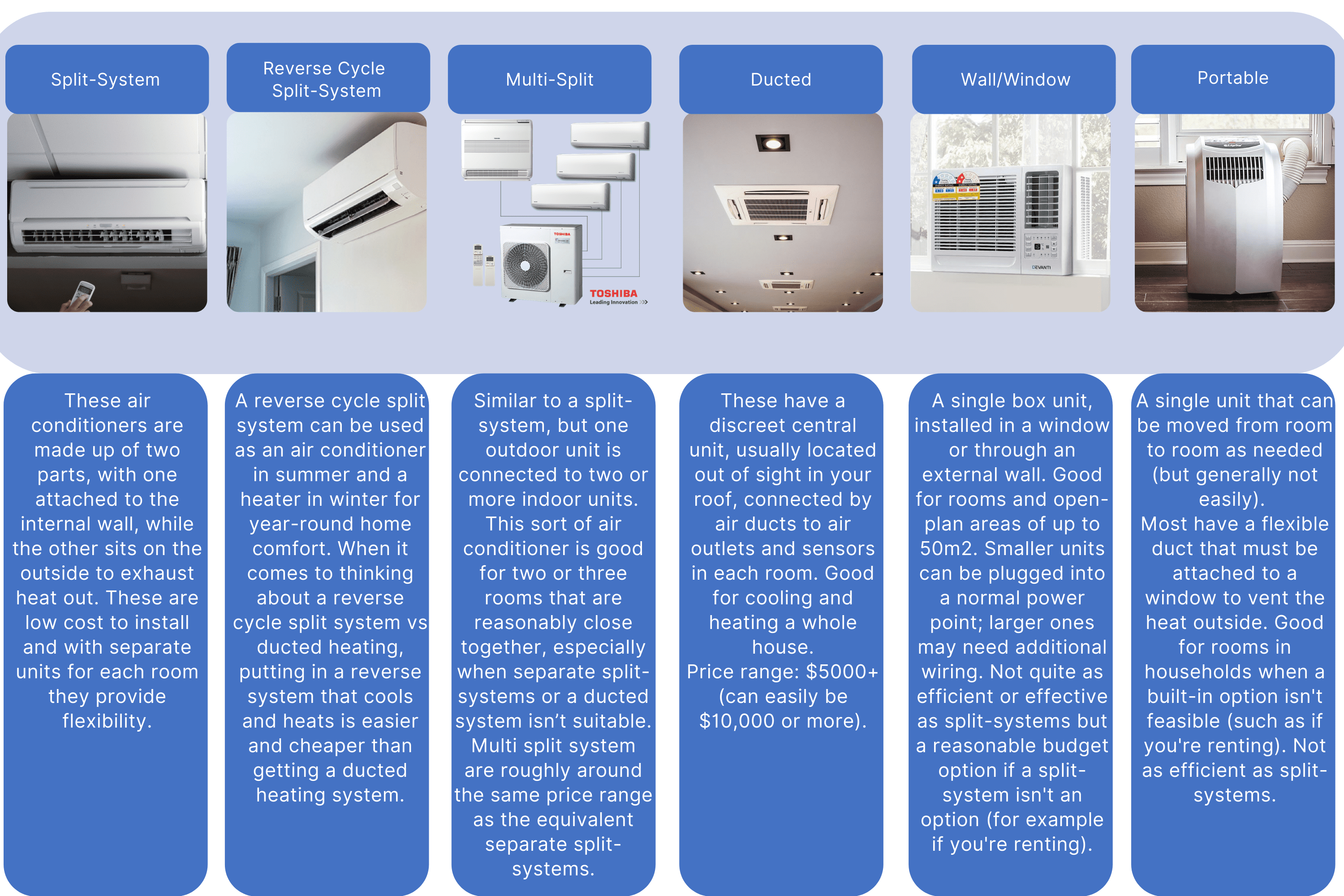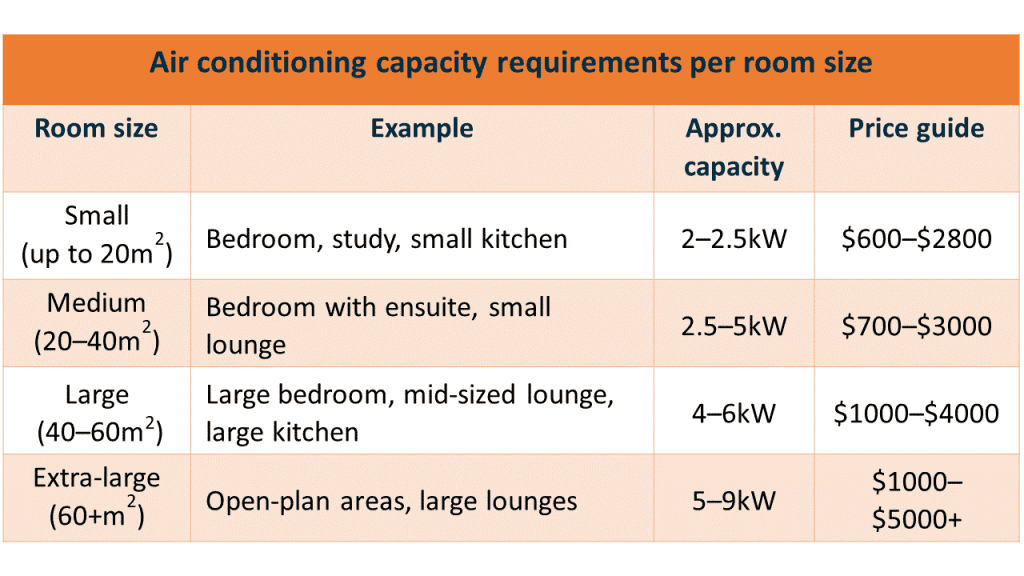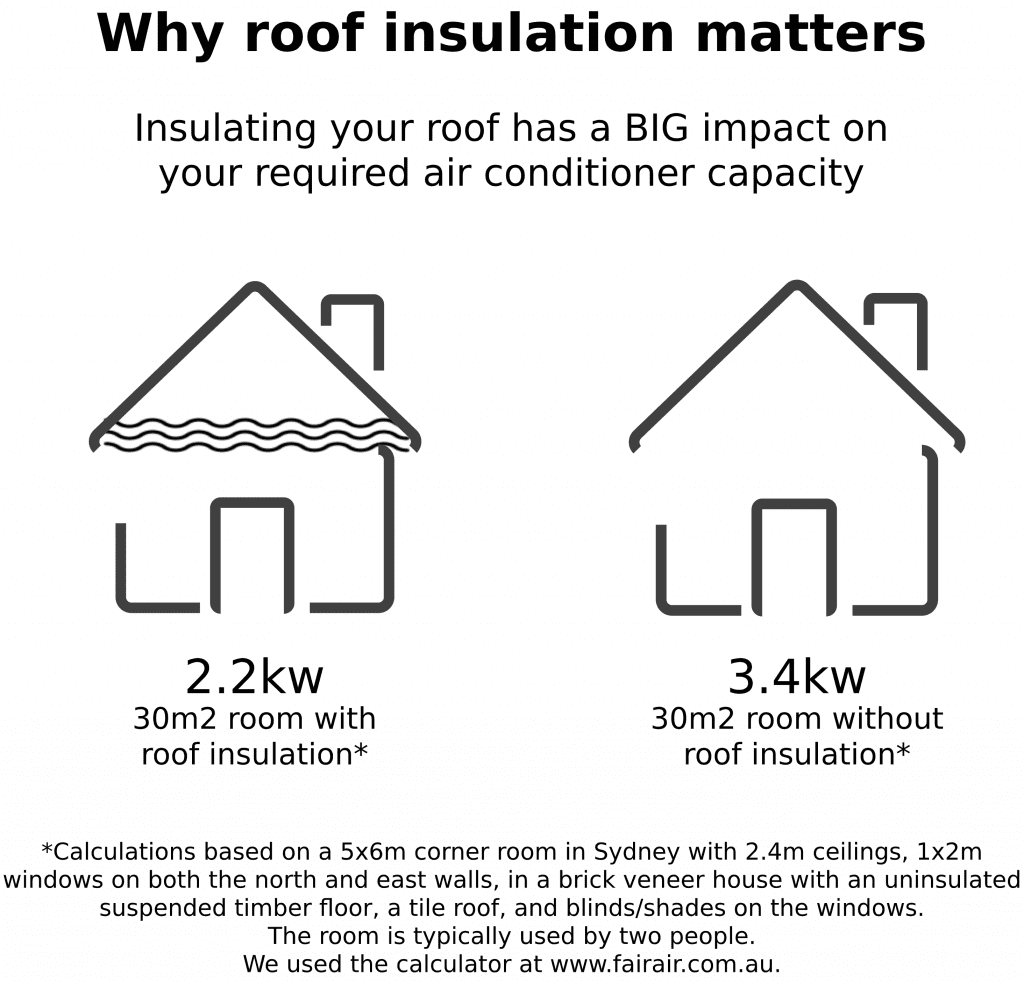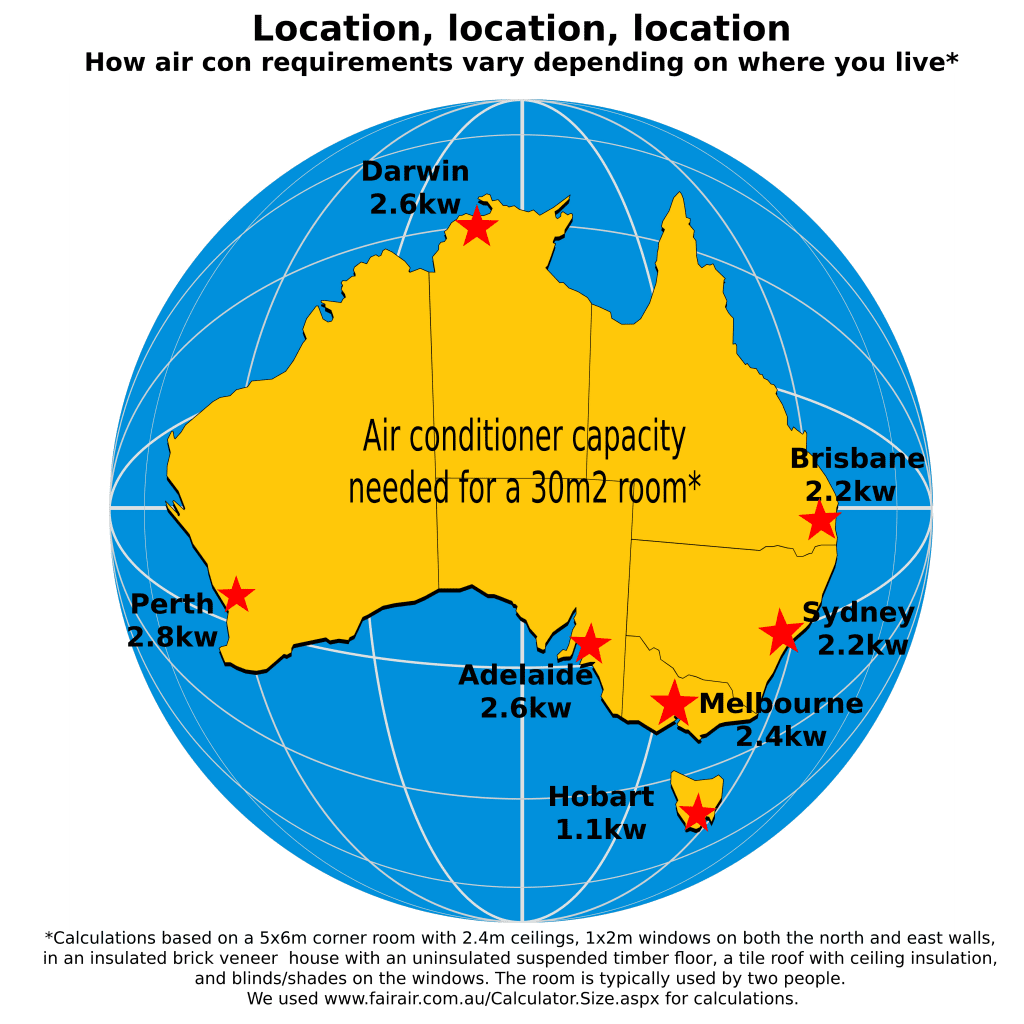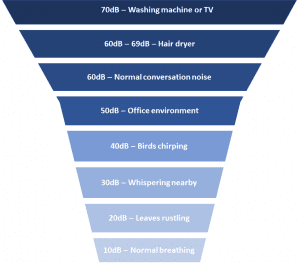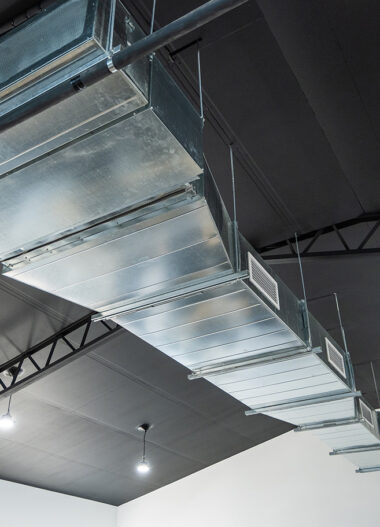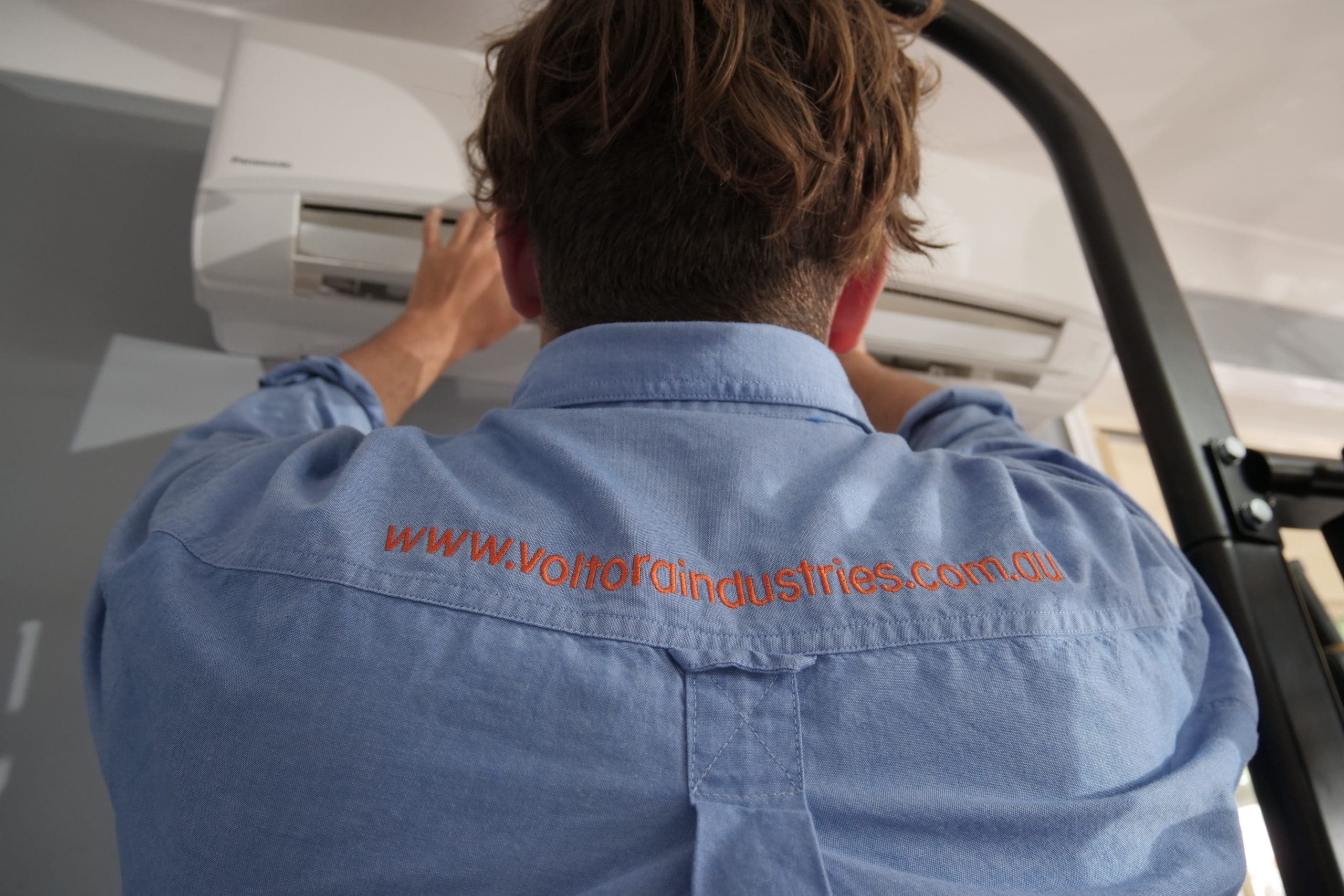
In the market for an air-conditioner?
Knowing how to choose the right air conditioner can be a challenge, but your aircon success is dependant on it. What size do you need? How much will it cost to run and how noisy will it be? Read on for more information which will help you to find the right model for your home or office.
This guide focuses mainly on split system air conditioners, as these are the most popular type of air conditioner in Australia, although some houses come with ducted aircon systems too.
On this page we will answer questions such as:
– Which type of air conditioner should I buy?
– What size air conditioner do I need?
– How to do a proper calculation?
– How much does it cost to run an air conditioner?
– How noisy are air conditioners?
– What features do I need to consider?
– Do air conditioners have HEPA filters?
– When is the best time to buy an air conditioner?
– How to install a split-system air conditioner?
What type of air conditioner should I get?
For most homes, a reverse-cycle split-system air conditioner will be the best option. Let us break down what that means.
While it may be tempting to just buy the biggest air conditioner you can get, in this instance, bigger isn’t always better. No matter how hot the weather gets, the decision to buy an air-conditioner should never be an impulse decision. An air-conditioner is an expansive long-term investment that has huge implications on your power bills and comfort levels alike – which is why it is important to do your homework before installing one.
So how can you find out which air conditioner is best suited to you? We’ll take you through the key factors.
The big four considerations
While room size is an important consideration, every home or office is different and there are many other factors that will impact your air conditioning capacity requirements.
The following four things have the biggest impact on determining the size of the air conditioning unit:
1. Room size
What’s the length, width and ceiling height? While floor space is important, the total volume of a room should also be taken into consideration as a room with high ceilings will require more energy to cool.
Here’s our rough guide to the air conditioner capacity (size) you’ll need to cool a particular room size.
2. Insulation:
Are your ceilings and walls insulated? What’s underneath and on top of the room? Ceiling insulation is one of the biggest factors in making your home thermally efficient.
Ceiling insulation can have the biggest impact on the size of the air conditioning unit that you will need. Consider installing roof insulation if you don’t have it – as it’ll save you money in the long run because you can get away with a smaller, cheaper air conditioner.
3. Location:
This plays a huge role in the size of air conditioner needed for a room! For example, a room in Darwin will need a more powerful air conditioner for cooling, compared to an otherwise identical room in Hobart.
4. Orientation:
Which way does the room face? How many windows does a room have? A large north- or west-facing window can let in a lot of heat in summer, whereas a shaded, southern-facing window will be cooler.
Some good locations for your air conditioner:
– You want to place your air conditioner in an area where the natural air flow of the space is going to work with the air conditioner not against it. If your air conditioner is facing an often-used door than it has to work twice as hard each time the door opens.
– If you are using a window unit a good way to get more out of your air conditioner by simple placement is to put the unit in a shaded window or to build a shade for it if it is placed in the sun. A window unit that is shaded can run 30% less electricity to cool down a space compared to a unit that is placed in a sunny location.
– Place your unit where the air flow can move about freely. Do not install your unit behind a piece of furniture and don’t block it with anything in front of it. It is imperative that an air conditioning unit is able to have a free flow of air surrounding it. If you block the air exchange you can actually burn out your unit very quickly.
– You need a power source so you will need to mount your AC where there is an outlet. It is best NOT to run extension cords to your AC.
– Portable units(not window units) will work best if they are as close to the centre of the room as possible. If it is a vented model than you will be limited by the ability to place the vent pipe out a window. Placing these units toward the centre of the room can help to radiate the cooling effects.
– Rooms with ceiling fans are also a great place to position and air conditioner because the ceiling fan will help to circulate the air in the room AND make you feel overall cooler which can result in you relying less on your air conditioner.
Air Conditioner Size matters
The above is a ballpark guide, but we recommend that you do an accurate calculation so you don’t end up with a system that’s drastically over- or under-sized. Bigger isn’t always better, and smaller isn’t always more economical. Don’t be tempted to go smaller to save money, or larger to keep your house feeling like a fridge.
Here’s what can happen if you super-size or skimp on your air con:
– Too big: the unit may run frequent short cycles to achieve the target temperature. This can mean:
* The room gets too hot or cold.
* The unit doesn’t dehumidify the air enough (so the room feels less comfortable).
* Power use increases.
* Running costs increase.
* More wear and tear on the system.
– Too small: the unit may have to run at maximum output more often. This can mean:
* The unit dries out the air too much.
* More wear and tear on the system.
* Power use increases.
Choose a model with capacity that’s either just right, or slightly more than you’ll need for the room. For example, if the room needs a 6kW model, then go for a unit with a rated cooling capacity in the range of 6 to 6.5kW.
How to do a proper calculation on air conditioner size
Some installers and online calculators offer only a simplistic analysis and may tend to recommend a larger capacity than you really need.
But there are a lot of variables to consider. For example, a well-insulated room with south-facing windows will be at the bottom end of the capacity range, while an uninsulated room with west-facing windows will be towards the top.
Likewise, a room in Brisbane will probably need a more powerful air conditioner compared to an otherwise identical room in Sydney.
A proper calculation takes all the room’s details into account:
– The size of the room: length, width and height.
– The type of room: living room, open-plan living room and kitchen, bedroom, etc.
– The size and orientation of the windows and glass doors. A large north- or west-facing window can let in a lot of heat in summer.
– Shading and curtains on the windows.
– Insulation of the floor, ceiling, and walls.
– The local climate.
How much does it cost to run an air conditioner?
Running costs for a medium-sized air conditioner ranges from around $400-$550 a year. Find out here how to save money on air conditioning.
Choice has done a measurement of running costs on their website – air conditioner reviews. As you can see in the below table, running costs can vary by a few hundred dollars a year, depending on the model.
How noisy are air conditioners?
Most modern split-system air conditioners are very quiet indoors and out, but it’s worth checking an air conditioner’s noise levels before you buy.
Choice.com.au measured noise as a part of their split system air conditioner reviews. In their latest test, the noise from indoor units ranged from 19dB to 53dB, and from the outdoor units, 42dB to 69dB (measured on the quietest indoor fan setting).
For comparison, here are some common sound levels:
A noisy indoor unit may interfere with your activities, conversation or sleep. A noisy outdoor unit can disturb you (if it’s too close to a bedroom or living room window) or your neighbours, so consider your outdoor unit placement carefully.
Most local councils have noise restrictions relating to the use of air conditioners. Check council regulations before buying, and your strata rules if you live in an apartment, especially if the outdoor unit needs to be installed close to a neighbour’s house.
Air Conditioner Features to consider
Fan speeds
The fan circulates cooled or heated air around the room. Look for a model with a wide airflow range and multiple fan speeds: from very high – to help the room cool down quickly, to very low – so there’s less noise and no unpleasant draught once you have the right temperature.
Operating modes
– Auto: Automatically chooses the mode required to keep the room at the chosen temperature.
– Cool: Pumps heat from the inside to the outside, cooling the room.
– Heat: Pumps heat from the outside to the inside, warming the room.
– Dry: Dehumidifies the air. Provides some cooling, but not as much as cooling mode.
– Fan only: Blows air without heating, cooling or drying, which is useful when all you want is a cooling breeze.
– Economy: Also called Eco mode, this reduces power consumption. Different brands implement this in different ways. It may simply reduce the cooling or heating output by adjusting the thermostat a degree or two, or it may use sensors to detect if no one is in the room and then reduce the cooling/heating.
Human presence sensor
This detects whether someone is in the room, so the unit knows to keep working. Some models even direct the air movement towards the sensed person. When no one is detected, the unit might switch to an economy mode to reduce power consumption.
Having this feature does not mean you can leave the air conditioner running for hours when the house is empty. You’re still much better off turning it off and using the timer function to turn it back on just before you return home or turning it on remotely via Wi-Fi (see next item).
This feature goes by different names. Mitsubishi Electric calls it Absence Detection; for Mitsubishi Heavy Industries, it’s Eco Operation; for Panasonic it’s ECONAVI; for Daikin, it’s Intelligent Eye.
Wi-Fi and apps control
Many newer models can connect to the wireless network in your home so you can control the air conditioner via an app on your smartphone – handy if you’re at work and want to turn it on before you get home, or you’re at home and you’ve misplaced the remote.
Some have this feature built in; others need a controller device added to the air conditioner to enable it.
Air filters and self-cleaning
Air conditioners offer increasingly sophisticated air filtration systems, to remove allergens, mould, bacteria, odours and dust from the air.
This is often accompanied by a self-cleaning function to keep the inside of the unit dry and reduce the build-up of dust and the growth of mould; this also helps keep the unit running more efficiently.
Remote control
Look for large, well-spaced buttons with easy-to-read labels, and a big, easy-to-read LCD screen.
The remote control should be easy to read and use with well-spaced buttons.
Sleep mode
This function adjusts the temperature in steps to a comfortable level for sleeping so the air conditioner doesn’t work as hard (and is quieter) when you’re sleeping.
Adjustable or oscillating louvres
We recommend you point them up for cool air and down for warm. This can be done via the remote for most models. Left and right adjustability helps direct air to where it’s needed.
Restart delay
Protects the compressor by preventing the air conditioner from starting up again too soon after being switched off.
Demand Response Enabling Device (DRED) or PeakSmart
If you have an air conditioner with the Demand Response Enabling Device (DRED, or PeakSmart) feature, and your energy provider offers the PeakSmart service, they’ll be able to remotely switch your air conditioner to an economy mode during times of high demand on the grid.
This will usually have no major impact on the air conditioner’s cooling (or heating) output – you might not even notice it happening – but it will reduce the amount of power the air conditioner is using, not just saving you money but also reducing the need for more ‘poles and wires’ to meet energy needs.
In Queensland Energex and Ergon pay incentives to customers who buy DRED-enabled air conditioners.
Wall-mounted or ceiling-mounted?
– High wall: the indoor unit is mounted high on a wall so its air flow can easily blow across the room.
– Floor-mounted: the indoor unit is at floor level, which may be better suit some rooms.
– Cassette: the indoor unit is mounted in the ceiling.
– Floor/ceiling: can be mounted on either the ceiling or the floor.
Operating range
Do you live in a very hot or cold region? Most models can operate in temperatures from about -10°C up to about 45°C or more. This is sufficient for most parts of Australia but check the air conditioner’s operating range before you buy, to make sure it can cope with any extremes in your area. (If you live in a hot and dry climate, an evaporative cooler can be a cheaper alternative to an air conditioner.)
Refrigerant gas
Ozone-depleting refrigerants such as chlorofluorocarbons (CFCs) have been essentially phased out, but the most commonly used current refrigerant gas type, hydrofluorocarbon or HFC, is also problematic. In 2016 a new international agreement was reached to phase out the use of HFCs over the next few decades.
We’re seeing a clear trend in the models we test towards the use of R32, instead of R410A; these are both HFCs, but R32 has a lower global warming potential and should also give improved efficiency.
Do air conditioners have HEPA filters?
All air conditioners have a dust filter in the indoor unit. This traps dust from the air as it circulates through, mainly to stop it clogging up the internal workings. But the dust filter will only have a minimal effect, if any, on smoke and other very fine particles.
To filter out smoke, you really need a HEPA filter. But HEPA filters can’t practically be fitted to split-system or ducted air conditioners, because air conditioners have to deliver quite significant volumes of air flow into the room, and would need massively powerful fans in the indoor unit to force that amount of air through the very tight weave of a HEPA filter.
Some air conditioners include an air purification filter based on ionisation. There are a few variations on this type, including photocatalytic and plasma stream filters. Ionisation filters can remove at least some smoke, but usually the claims for these filters focus on the removal of fine dust, odours, allergens and germs.
Online, you may find various aftermarket air purifying filters for air conditioners, described as electrostatic, activated carbon or similar. They claim to be compatible with major air conditioner brands and in some cases can be cut to size to suit different models. Be cautious with any such filters. While they may provide filtration as claimed, it’s highly unlikely that they’ve been thoroughly tested with every air conditioner brand, and using non-genuine parts may reduce your air conditioner’s performance, possibly cause damage and could void your warranty.
When is the best time to buy an air conditioner?
Avoid buying in peak season if you can; that will be summer in most parts of Australia, but could be mid-winter too if you’re in a colder region. Installers are usually very busy in these periods and you might have to wait some weeks before your new unit can be installed.
If possible, shop around before the peak season starts, so that your new unit is installed and ready for when you’ll need it most.
Alternatively, it can be worth buying just after the season ends. Old stock may be discounted as retailers make room for new models.
How to install a split-system air conditioner?
With the blazing temperatures that Brisbane can experience, an air conditioning system brings much needed relief on hot summer days.
But the level of comfort that you enjoy from your air conditioning system depends heavily on who installs your air conditioning system in the first place.
You’ll need a licensed air conditioner installer because of the gas refrigerant. Look for an installer with ARCtick approval and get a few quotes. Most traders offer supply and install packages, and some installation only (meaning you will need to purchase the unit yourself). At Voltora, we offer both supply and installation as well as installation only, so you have the flexibility of both options. Voltora uses the highest quality air conditioners to suit any type of budget. These brands include household names like: Panasonic, Fujitsu, Mitsubishi and Daikin. Voltora are the Brisbane Air Con Specialists who are well-versed in air-con installations for these brands and know how best to set up your system for optimal comfort and energy efficiency. We can also help you decide whether to repair or replace your air conditioner.
As well as an ARCtick accreditation, your air conditioner installer should have an electrical qualification to wire your air conditioner into your home. Many don’t, but this means they will be unable to offer a warranty on the electrical work, only the air conditioner itself.

It’s generally better to install an air conditioner on a longer wall of a room, and not directly above a window, but your installer should recommend the best place for your individual situation.
The outdoor unit of your split system air conditioner needs to be installed on a firm base (for example, a concrete slab) or attached to a wall using sturdy brackets. It should be as close as possible to the indoor air outlet, ideally with about three to five metres of pipes between the two units.
Shade the outdoor part of your air conditioner from direct sunlight – for example, by installing it on a southern wall or providing an awning.
Single-phase power is all you need for most single (and multi) split-system air conditioners. Three-phase power might be needed for very large multi-split or ducted systems, say 20kW capacity or more.
Many air con installers out there give you a price list, ask you to choose a brand, and install your system – end of project. But at Voltora, we go the extra mile. No two split-system air con projects are the same, and we understand that. From determining your air con needs, to analysing your installation’s constraints, to your electrical setup, Voltora Air Con Specialists work with you to identify the best air con set-up, so that you can come home to comfort each day. When you work with Voltora’s Air Con Specialists, you don’t just get your split-system air con system installed; you get tailored, expert advice that results in cool (or hot), effective air and regular aircon servicing and maintenance.
When you choose the right air conditioner, don’t forget to clean the filters periodically and have the unit serviced regularly. Learn more about the importance of cleaning and maintaining your air conditioner. Remember, when purchasing or maintaining air conditioners, it’s always good to have the electrician Brisbane residents trust on your side! Get in touch with Voltora Industries today and we’ll help solve all your aircon problems and keep you cool!
Lets get started

